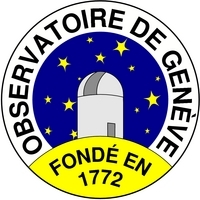
| INTEGRALPlanckGaiaPOLARCHEOPSEuclidATHENA |
| HEAVENSFACTCTALOFTSPICAJEM-EUSOXIPEeXTPTheseus |
| XRISMMAGBOUNDSMARTNet |
| ISDCCDCI |
| Data Centre for Astrophysics Astronomy Department of the University of Geneva |
Probing the cosmic-ray content of galaxy clusters by stacking Fermi-LAT count maps
| The cosmic-ray content of galaxy clusters is expected to produce a gamma-ray signal that could be detected by the Fermi Gamma-ray Space Telescope. We show here that even by stacking the Fermi observations at the position of 53 known galaxy clusters we still cannot detect such an emission. |
|---|
ABSTRACT
Observation in radio have shown that galaxy clusters are giant reservoirs of cosmic rays (CR). Although a gamma-ray signal from the cluster volume is expected to arise through interactions of CR protons with the ambient plasma, a confirming observation is still missing. We search for a cumulative gamma-ray emission in direction of galaxy clusters by analysing a collection of stacked Fermi-LAT count maps. Additionally, we investigate possible systematic differences in the emission between cool-core and non-cool core cluster populations. Making use of a sample of 53 clusters selected from the HIFLUGCS catalog, we do not detect a significant signal from the stacked sample. The upper limit on the average flux per cluster derived for the total stacked sample is at the level of a few 10-11 ph cm-2 s-1 at 95% confidence level in the 1-300 GeV band, assuming power-law spectra with photon indices 2.0, 2.4, 2.8 and 3.2. Separate stacking of the cool core and non-cool core clusters in the sample lead to similar values of around 5x10-11 ph cm-2 s-1 and 2x10-11 ph cm-2 s-1, respectively. Under the assumption that decaying π0, produced in collisions between CRs and the ambient thermal gas, are responsible for the gamma-ray emission, we set upper limits on the average CR content in galaxy clusters. For the entire cluster population, our upper limit on the gamma-ray flux translates into an upper limit on the average CR-to-thermal energy ratio of 4.6% for a photon index of 2.4, although it is possible for individual systems to exceed this limit. Our 95% upper limits are at the level expected from numerical simulations, which likely suggests that the injection of CR at cosmological shocks is less efficient than previously assumed.
| by Benjamin Huber on 2013-10-02 | >> Fermi science results | >> All science results |







